MGT301A: Ethics and Sustainability - Gender Discrimination at Amazon
VerifiedAdded on 2022/09/17
|12
|2964
|28
Report
AI Summary
This report examines the issue of gender discrimination within Amazon, analyzing the company's practices through the lens of stakeholder engagement theory. It highlights instances of alleged unfair treatment of female employees, including terminations following medical leave and the underrepresentation of women in leadership positions. The report details how Amazon's actions may violate principles of fair employment, ethical conduct, and stakeholder management. It assesses the impact of these actions on the company's reputation and potential legal consequences. Furthermore, the report provides alternative solutions to address the issue of gender disparity and recommends ways for Amazon to improve its policies and practices to ensure equal opportunities and treatment for all employees, fostering a more inclusive and ethical workplace.

Running head: GENDER DISCRIMINATION
Gender Discrimination
Name of the Student
Name of the University
Author Note
Gender Discrimination
Name of the Student
Name of the University
Author Note
Paraphrase This Document
Need a fresh take? Get an instant paraphrase of this document with our AI Paraphraser
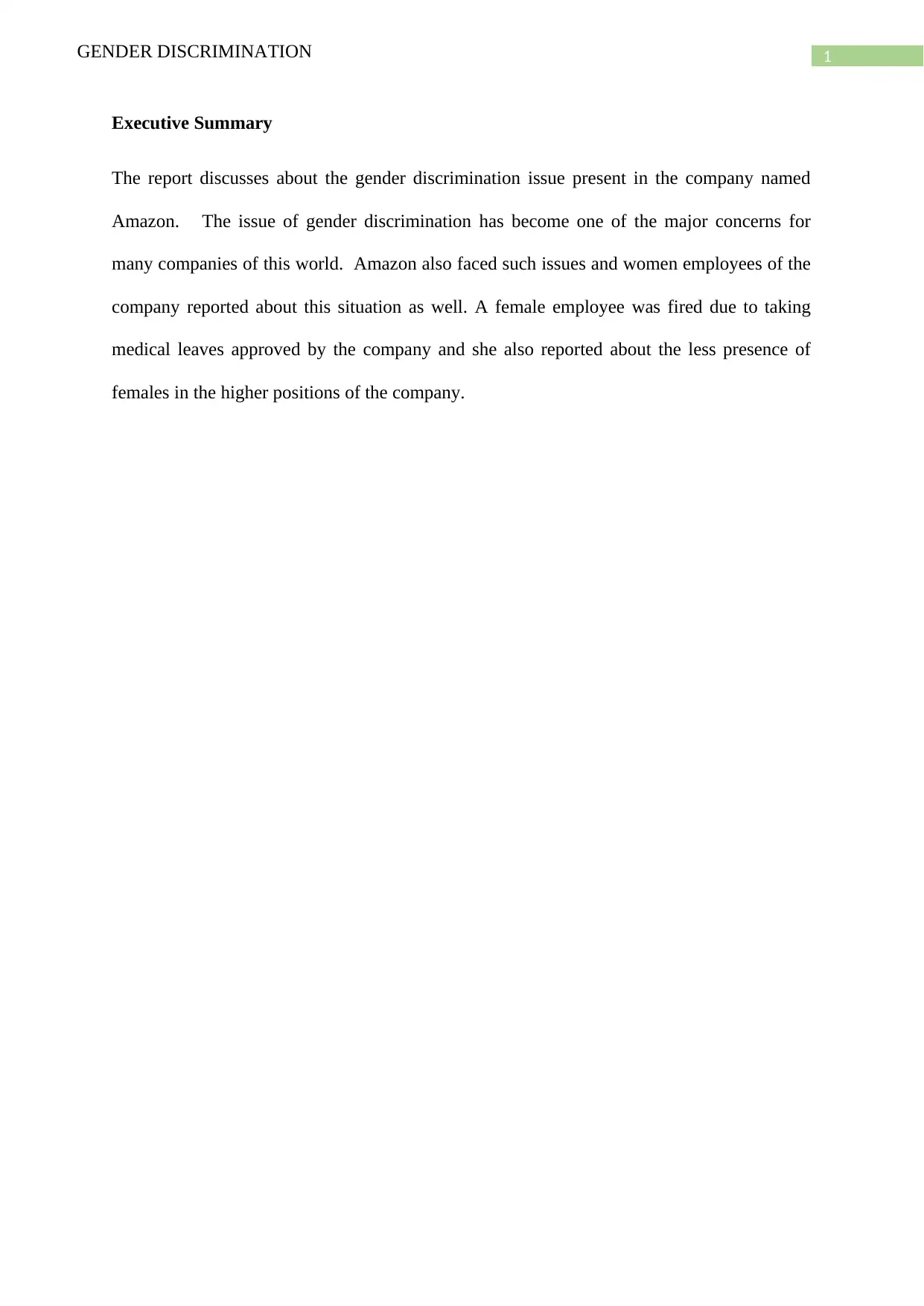
1GENDER DISCRIMINATION
Executive Summary
The report discusses about the gender discrimination issue present in the company named
Amazon. The issue of gender discrimination has become one of the major concerns for
many companies of this world. Amazon also faced such issues and women employees of the
company reported about this situation as well. A female employee was fired due to taking
medical leaves approved by the company and she also reported about the less presence of
females in the higher positions of the company.
Executive Summary
The report discusses about the gender discrimination issue present in the company named
Amazon. The issue of gender discrimination has become one of the major concerns for
many companies of this world. Amazon also faced such issues and women employees of the
company reported about this situation as well. A female employee was fired due to taking
medical leaves approved by the company and she also reported about the less presence of
females in the higher positions of the company.

2GENDER DISCRIMINATION
Table of Contents
Introduction...........................................................................................................................................3
Summary of the Scenario......................................................................................................................3
Description of Theory............................................................................................................................4
Analysis of Theory................................................................................................................................5
Alternative Solution...............................................................................................................................7
Recommendation...................................................................................................................................8
Conclusion.............................................................................................................................................8
Table of Contents
Introduction...........................................................................................................................................3
Summary of the Scenario......................................................................................................................3
Description of Theory............................................................................................................................4
Analysis of Theory................................................................................................................................5
Alternative Solution...............................................................................................................................7
Recommendation...................................................................................................................................8
Conclusion.............................................................................................................................................8
⊘ This is a preview!⊘
Do you want full access?
Subscribe today to unlock all pages.

Trusted by 1+ million students worldwide
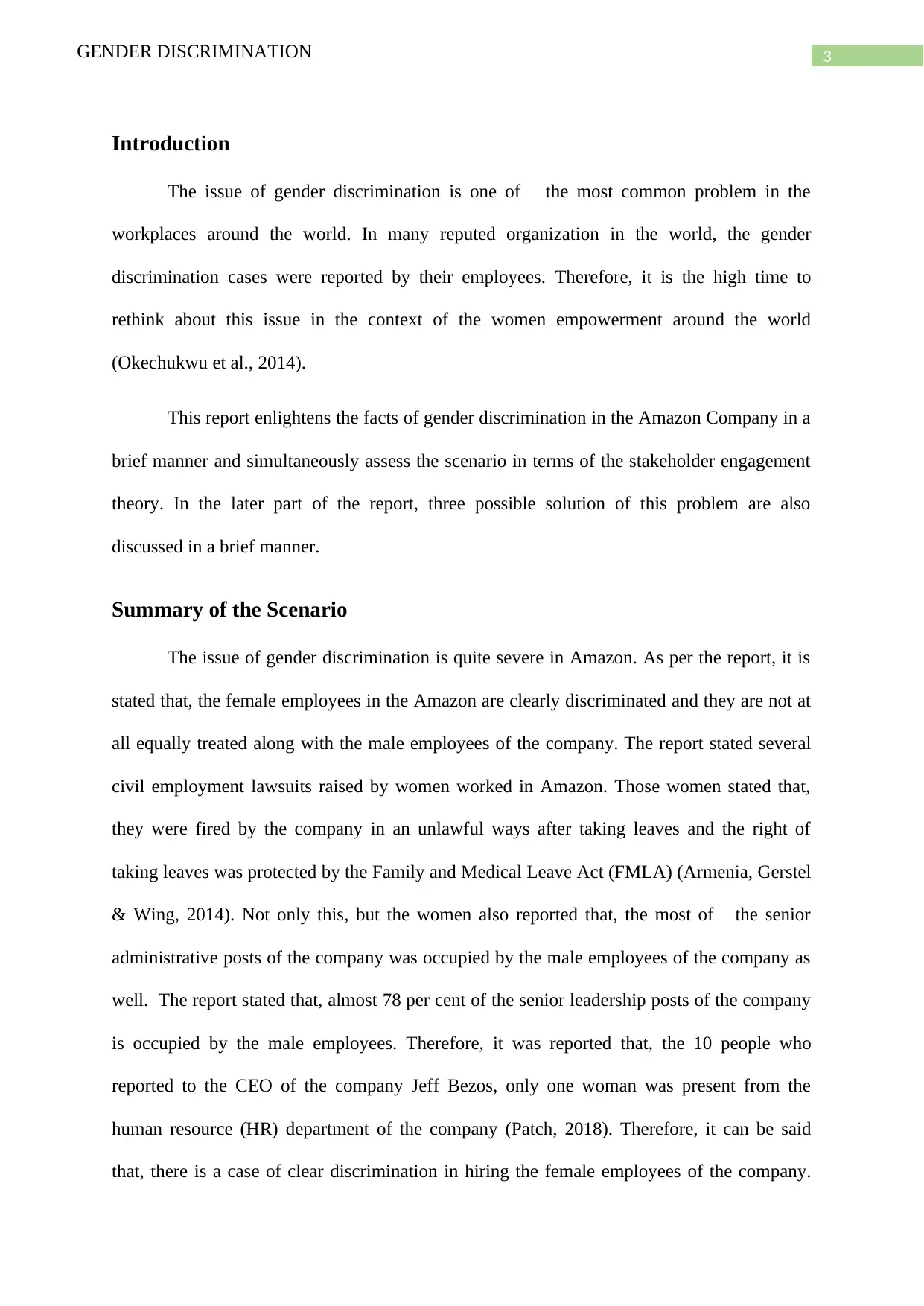
3GENDER DISCRIMINATION
Introduction
The issue of gender discrimination is one of the most common problem in the
workplaces around the world. In many reputed organization in the world, the gender
discrimination cases were reported by their employees. Therefore, it is the high time to
rethink about this issue in the context of the women empowerment around the world
(Okechukwu et al., 2014).
This report enlightens the facts of gender discrimination in the Amazon Company in a
brief manner and simultaneously assess the scenario in terms of the stakeholder engagement
theory. In the later part of the report, three possible solution of this problem are also
discussed in a brief manner.
Summary of the Scenario
The issue of gender discrimination is quite severe in Amazon. As per the report, it is
stated that, the female employees in the Amazon are clearly discriminated and they are not at
all equally treated along with the male employees of the company. The report stated several
civil employment lawsuits raised by women worked in Amazon. Those women stated that,
they were fired by the company in an unlawful ways after taking leaves and the right of
taking leaves was protected by the Family and Medical Leave Act (FMLA) (Armenia, Gerstel
& Wing, 2014). Not only this, but the women also reported that, the most of the senior
administrative posts of the company was occupied by the male employees of the company as
well. The report stated that, almost 78 per cent of the senior leadership posts of the company
is occupied by the male employees. Therefore, it was reported that, the 10 people who
reported to the CEO of the company Jeff Bezos, only one woman was present from the
human resource (HR) department of the company (Patch, 2018). Therefore, it can be said
that, there is a case of clear discrimination in hiring the female employees of the company.
Introduction
The issue of gender discrimination is one of the most common problem in the
workplaces around the world. In many reputed organization in the world, the gender
discrimination cases were reported by their employees. Therefore, it is the high time to
rethink about this issue in the context of the women empowerment around the world
(Okechukwu et al., 2014).
This report enlightens the facts of gender discrimination in the Amazon Company in a
brief manner and simultaneously assess the scenario in terms of the stakeholder engagement
theory. In the later part of the report, three possible solution of this problem are also
discussed in a brief manner.
Summary of the Scenario
The issue of gender discrimination is quite severe in Amazon. As per the report, it is
stated that, the female employees in the Amazon are clearly discriminated and they are not at
all equally treated along with the male employees of the company. The report stated several
civil employment lawsuits raised by women worked in Amazon. Those women stated that,
they were fired by the company in an unlawful ways after taking leaves and the right of
taking leaves was protected by the Family and Medical Leave Act (FMLA) (Armenia, Gerstel
& Wing, 2014). Not only this, but the women also reported that, the most of the senior
administrative posts of the company was occupied by the male employees of the company as
well. The report stated that, almost 78 per cent of the senior leadership posts of the company
is occupied by the male employees. Therefore, it was reported that, the 10 people who
reported to the CEO of the company Jeff Bezos, only one woman was present from the
human resource (HR) department of the company (Patch, 2018). Therefore, it can be said
that, there is a case of clear discrimination in hiring the female employees of the company.
Paraphrase This Document
Need a fresh take? Get an instant paraphrase of this document with our AI Paraphraser
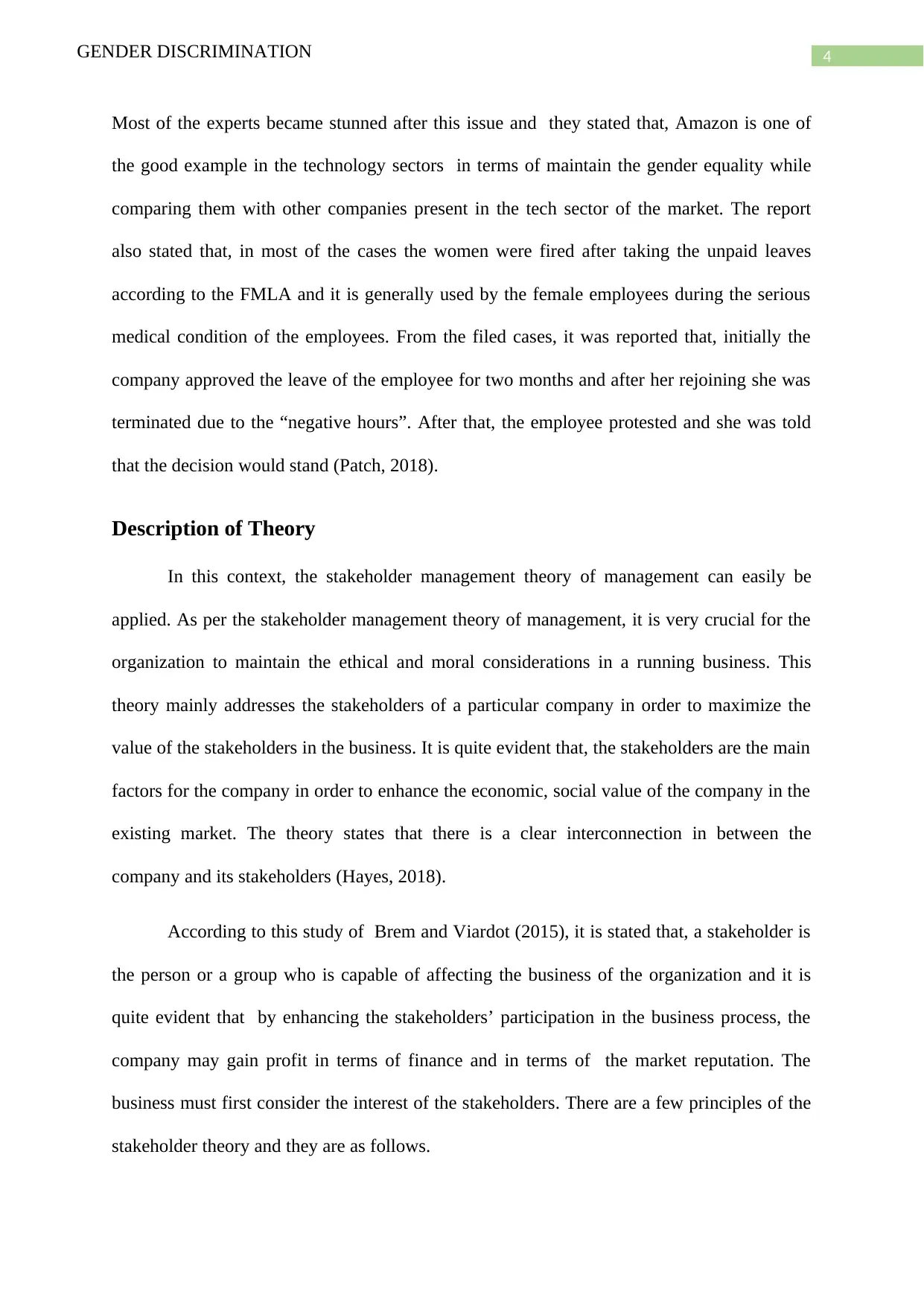
4GENDER DISCRIMINATION
Most of the experts became stunned after this issue and they stated that, Amazon is one of
the good example in the technology sectors in terms of maintain the gender equality while
comparing them with other companies present in the tech sector of the market. The report
also stated that, in most of the cases the women were fired after taking the unpaid leaves
according to the FMLA and it is generally used by the female employees during the serious
medical condition of the employees. From the filed cases, it was reported that, initially the
company approved the leave of the employee for two months and after her rejoining she was
terminated due to the “negative hours”. After that, the employee protested and she was told
that the decision would stand (Patch, 2018).
Description of Theory
In this context, the stakeholder management theory of management can easily be
applied. As per the stakeholder management theory of management, it is very crucial for the
organization to maintain the ethical and moral considerations in a running business. This
theory mainly addresses the stakeholders of a particular company in order to maximize the
value of the stakeholders in the business. It is quite evident that, the stakeholders are the main
factors for the company in order to enhance the economic, social value of the company in the
existing market. The theory states that there is a clear interconnection in between the
company and its stakeholders (Hayes, 2018).
According to this study of Brem and Viardot (2015), it is stated that, a stakeholder is
the person or a group who is capable of affecting the business of the organization and it is
quite evident that by enhancing the stakeholders’ participation in the business process, the
company may gain profit in terms of finance and in terms of the market reputation. The
business must first consider the interest of the stakeholders. There are a few principles of the
stakeholder theory and they are as follows.
Most of the experts became stunned after this issue and they stated that, Amazon is one of
the good example in the technology sectors in terms of maintain the gender equality while
comparing them with other companies present in the tech sector of the market. The report
also stated that, in most of the cases the women were fired after taking the unpaid leaves
according to the FMLA and it is generally used by the female employees during the serious
medical condition of the employees. From the filed cases, it was reported that, initially the
company approved the leave of the employee for two months and after her rejoining she was
terminated due to the “negative hours”. After that, the employee protested and she was told
that the decision would stand (Patch, 2018).
Description of Theory
In this context, the stakeholder management theory of management can easily be
applied. As per the stakeholder management theory of management, it is very crucial for the
organization to maintain the ethical and moral considerations in a running business. This
theory mainly addresses the stakeholders of a particular company in order to maximize the
value of the stakeholders in the business. It is quite evident that, the stakeholders are the main
factors for the company in order to enhance the economic, social value of the company in the
existing market. The theory states that there is a clear interconnection in between the
company and its stakeholders (Hayes, 2018).
According to this study of Brem and Viardot (2015), it is stated that, a stakeholder is
the person or a group who is capable of affecting the business of the organization and it is
quite evident that by enhancing the stakeholders’ participation in the business process, the
company may gain profit in terms of finance and in terms of the market reputation. The
business must first consider the interest of the stakeholders. There are a few principles of the
stakeholder theory and they are as follows.
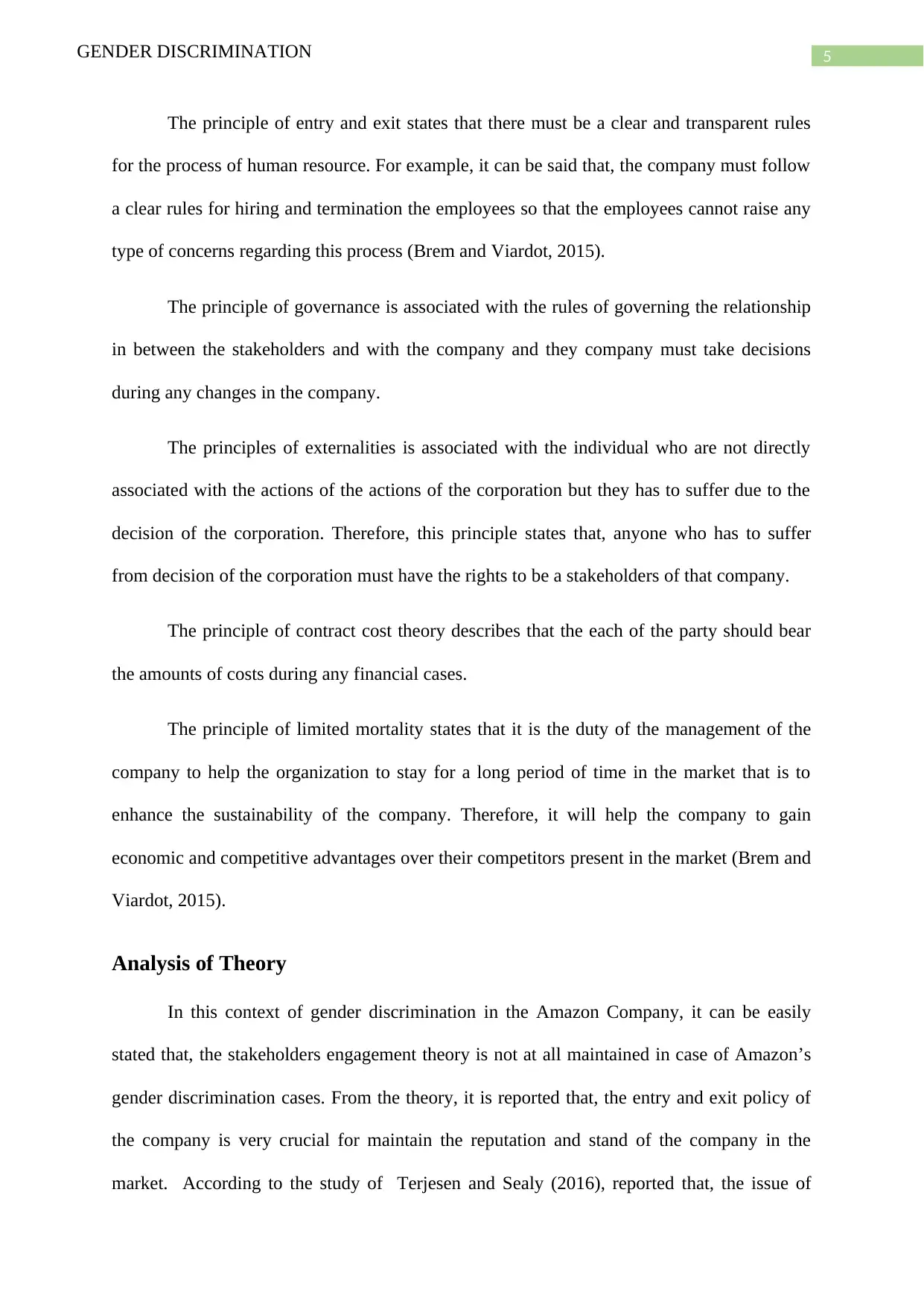
5GENDER DISCRIMINATION
The principle of entry and exit states that there must be a clear and transparent rules
for the process of human resource. For example, it can be said that, the company must follow
a clear rules for hiring and termination the employees so that the employees cannot raise any
type of concerns regarding this process (Brem and Viardot, 2015).
The principle of governance is associated with the rules of governing the relationship
in between the stakeholders and with the company and they company must take decisions
during any changes in the company.
The principles of externalities is associated with the individual who are not directly
associated with the actions of the actions of the corporation but they has to suffer due to the
decision of the corporation. Therefore, this principle states that, anyone who has to suffer
from decision of the corporation must have the rights to be a stakeholders of that company.
The principle of contract cost theory describes that the each of the party should bear
the amounts of costs during any financial cases.
The principle of limited mortality states that it is the duty of the management of the
company to help the organization to stay for a long period of time in the market that is to
enhance the sustainability of the company. Therefore, it will help the company to gain
economic and competitive advantages over their competitors present in the market (Brem and
Viardot, 2015).
Analysis of Theory
In this context of gender discrimination in the Amazon Company, it can be easily
stated that, the stakeholders engagement theory is not at all maintained in case of Amazon’s
gender discrimination cases. From the theory, it is reported that, the entry and exit policy of
the company is very crucial for maintain the reputation and stand of the company in the
market. According to the study of Terjesen and Sealy (2016), reported that, the issue of
The principle of entry and exit states that there must be a clear and transparent rules
for the process of human resource. For example, it can be said that, the company must follow
a clear rules for hiring and termination the employees so that the employees cannot raise any
type of concerns regarding this process (Brem and Viardot, 2015).
The principle of governance is associated with the rules of governing the relationship
in between the stakeholders and with the company and they company must take decisions
during any changes in the company.
The principles of externalities is associated with the individual who are not directly
associated with the actions of the actions of the corporation but they has to suffer due to the
decision of the corporation. Therefore, this principle states that, anyone who has to suffer
from decision of the corporation must have the rights to be a stakeholders of that company.
The principle of contract cost theory describes that the each of the party should bear
the amounts of costs during any financial cases.
The principle of limited mortality states that it is the duty of the management of the
company to help the organization to stay for a long period of time in the market that is to
enhance the sustainability of the company. Therefore, it will help the company to gain
economic and competitive advantages over their competitors present in the market (Brem and
Viardot, 2015).
Analysis of Theory
In this context of gender discrimination in the Amazon Company, it can be easily
stated that, the stakeholders engagement theory is not at all maintained in case of Amazon’s
gender discrimination cases. From the theory, it is reported that, the entry and exit policy of
the company is very crucial for maintain the reputation and stand of the company in the
market. According to the study of Terjesen and Sealy (2016), reported that, the issue of
⊘ This is a preview!⊘
Do you want full access?
Subscribe today to unlock all pages.

Trusted by 1+ million students worldwide
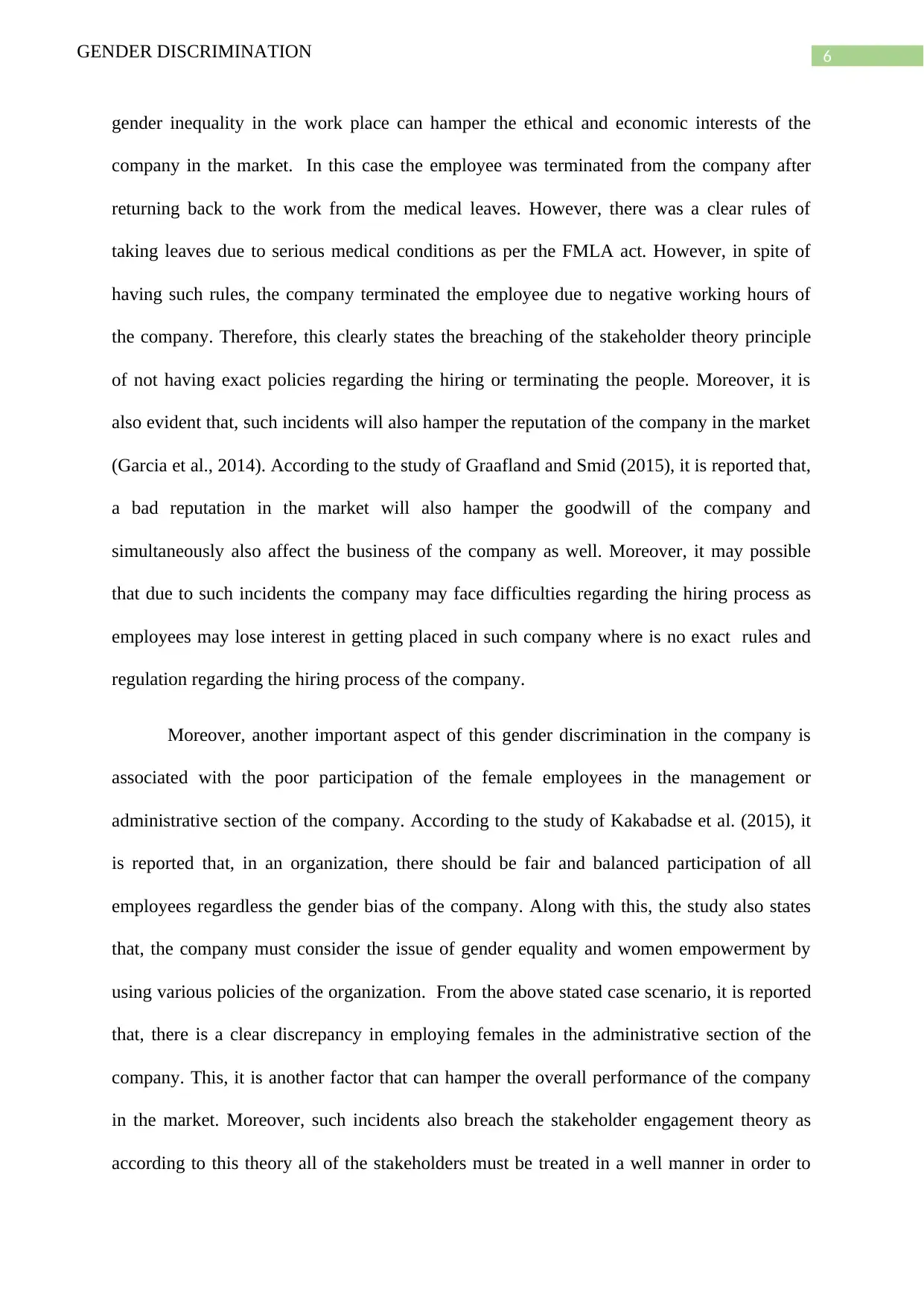
6GENDER DISCRIMINATION
gender inequality in the work place can hamper the ethical and economic interests of the
company in the market. In this case the employee was terminated from the company after
returning back to the work from the medical leaves. However, there was a clear rules of
taking leaves due to serious medical conditions as per the FMLA act. However, in spite of
having such rules, the company terminated the employee due to negative working hours of
the company. Therefore, this clearly states the breaching of the stakeholder theory principle
of not having exact policies regarding the hiring or terminating the people. Moreover, it is
also evident that, such incidents will also hamper the reputation of the company in the market
(Garcia et al., 2014). According to the study of Graafland and Smid (2015), it is reported that,
a bad reputation in the market will also hamper the goodwill of the company and
simultaneously also affect the business of the company as well. Moreover, it may possible
that due to such incidents the company may face difficulties regarding the hiring process as
employees may lose interest in getting placed in such company where is no exact rules and
regulation regarding the hiring process of the company.
Moreover, another important aspect of this gender discrimination in the company is
associated with the poor participation of the female employees in the management or
administrative section of the company. According to the study of Kakabadse et al. (2015), it
is reported that, in an organization, there should be fair and balanced participation of all
employees regardless the gender bias of the company. Along with this, the study also states
that, the company must consider the issue of gender equality and women empowerment by
using various policies of the organization. From the above stated case scenario, it is reported
that, there is a clear discrepancy in employing females in the administrative section of the
company. This, it is another factor that can hamper the overall performance of the company
in the market. Moreover, such incidents also breach the stakeholder engagement theory as
according to this theory all of the stakeholders must be treated in a well manner in order to
gender inequality in the work place can hamper the ethical and economic interests of the
company in the market. In this case the employee was terminated from the company after
returning back to the work from the medical leaves. However, there was a clear rules of
taking leaves due to serious medical conditions as per the FMLA act. However, in spite of
having such rules, the company terminated the employee due to negative working hours of
the company. Therefore, this clearly states the breaching of the stakeholder theory principle
of not having exact policies regarding the hiring or terminating the people. Moreover, it is
also evident that, such incidents will also hamper the reputation of the company in the market
(Garcia et al., 2014). According to the study of Graafland and Smid (2015), it is reported that,
a bad reputation in the market will also hamper the goodwill of the company and
simultaneously also affect the business of the company as well. Moreover, it may possible
that due to such incidents the company may face difficulties regarding the hiring process as
employees may lose interest in getting placed in such company where is no exact rules and
regulation regarding the hiring process of the company.
Moreover, another important aspect of this gender discrimination in the company is
associated with the poor participation of the female employees in the management or
administrative section of the company. According to the study of Kakabadse et al. (2015), it
is reported that, in an organization, there should be fair and balanced participation of all
employees regardless the gender bias of the company. Along with this, the study also states
that, the company must consider the issue of gender equality and women empowerment by
using various policies of the organization. From the above stated case scenario, it is reported
that, there is a clear discrepancy in employing females in the administrative section of the
company. This, it is another factor that can hamper the overall performance of the company
in the market. Moreover, such incidents also breach the stakeholder engagement theory as
according to this theory all of the stakeholders must be treated in a well manner in order to
Paraphrase This Document
Need a fresh take? Get an instant paraphrase of this document with our AI Paraphraser
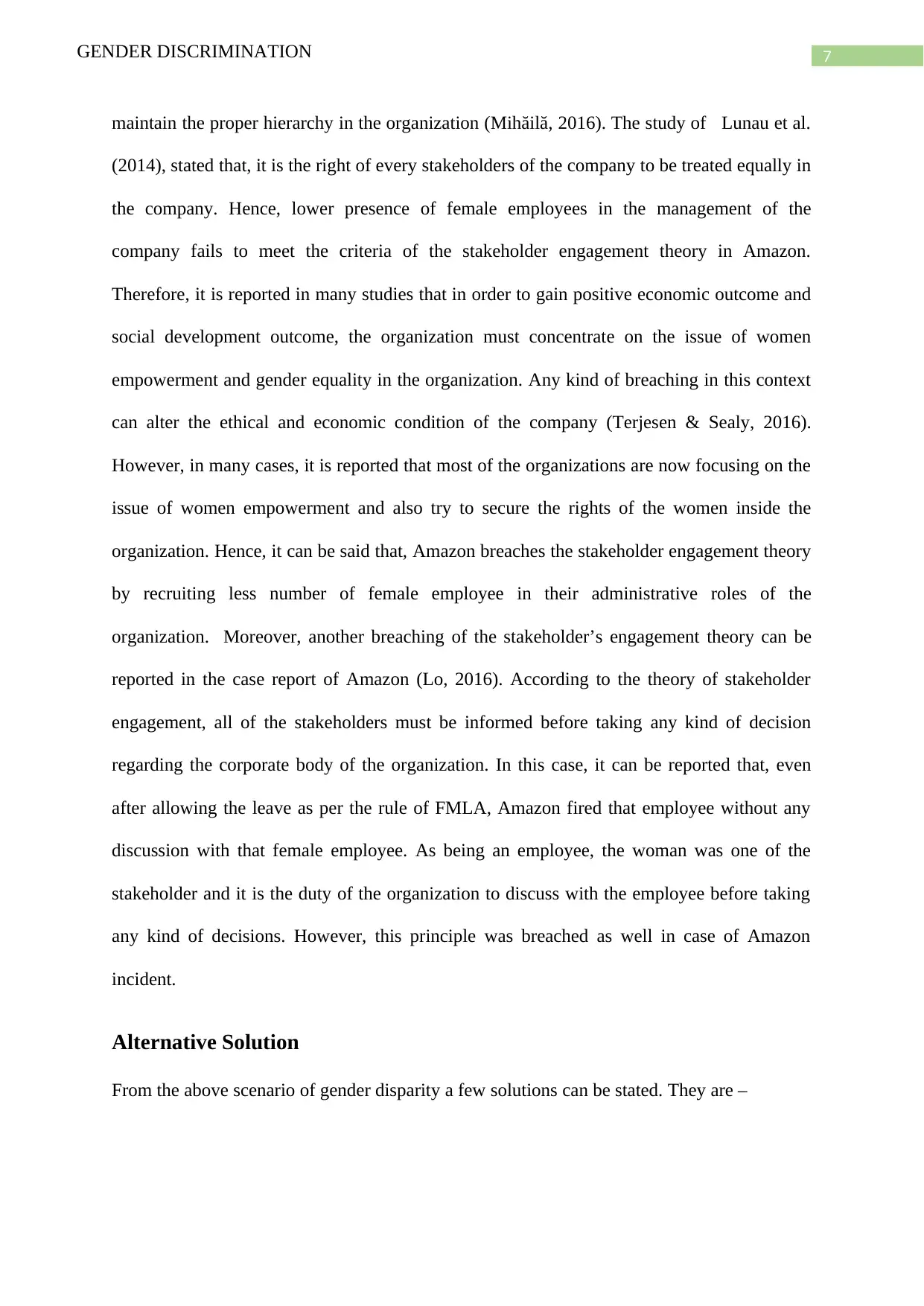
7GENDER DISCRIMINATION
maintain the proper hierarchy in the organization (Mihăilă, 2016). The study of Lunau et al.
(2014), stated that, it is the right of every stakeholders of the company to be treated equally in
the company. Hence, lower presence of female employees in the management of the
company fails to meet the criteria of the stakeholder engagement theory in Amazon.
Therefore, it is reported in many studies that in order to gain positive economic outcome and
social development outcome, the organization must concentrate on the issue of women
empowerment and gender equality in the organization. Any kind of breaching in this context
can alter the ethical and economic condition of the company (Terjesen & Sealy, 2016).
However, in many cases, it is reported that most of the organizations are now focusing on the
issue of women empowerment and also try to secure the rights of the women inside the
organization. Hence, it can be said that, Amazon breaches the stakeholder engagement theory
by recruiting less number of female employee in their administrative roles of the
organization. Moreover, another breaching of the stakeholder’s engagement theory can be
reported in the case report of Amazon (Lo, 2016). According to the theory of stakeholder
engagement, all of the stakeholders must be informed before taking any kind of decision
regarding the corporate body of the organization. In this case, it can be reported that, even
after allowing the leave as per the rule of FMLA, Amazon fired that employee without any
discussion with that female employee. As being an employee, the woman was one of the
stakeholder and it is the duty of the organization to discuss with the employee before taking
any kind of decisions. However, this principle was breached as well in case of Amazon
incident.
Alternative Solution
From the above scenario of gender disparity a few solutions can be stated. They are –
maintain the proper hierarchy in the organization (Mihăilă, 2016). The study of Lunau et al.
(2014), stated that, it is the right of every stakeholders of the company to be treated equally in
the company. Hence, lower presence of female employees in the management of the
company fails to meet the criteria of the stakeholder engagement theory in Amazon.
Therefore, it is reported in many studies that in order to gain positive economic outcome and
social development outcome, the organization must concentrate on the issue of women
empowerment and gender equality in the organization. Any kind of breaching in this context
can alter the ethical and economic condition of the company (Terjesen & Sealy, 2016).
However, in many cases, it is reported that most of the organizations are now focusing on the
issue of women empowerment and also try to secure the rights of the women inside the
organization. Hence, it can be said that, Amazon breaches the stakeholder engagement theory
by recruiting less number of female employee in their administrative roles of the
organization. Moreover, another breaching of the stakeholder’s engagement theory can be
reported in the case report of Amazon (Lo, 2016). According to the theory of stakeholder
engagement, all of the stakeholders must be informed before taking any kind of decision
regarding the corporate body of the organization. In this case, it can be reported that, even
after allowing the leave as per the rule of FMLA, Amazon fired that employee without any
discussion with that female employee. As being an employee, the woman was one of the
stakeholder and it is the duty of the organization to discuss with the employee before taking
any kind of decisions. However, this principle was breached as well in case of Amazon
incident.
Alternative Solution
From the above scenario of gender disparity a few solutions can be stated. They are –
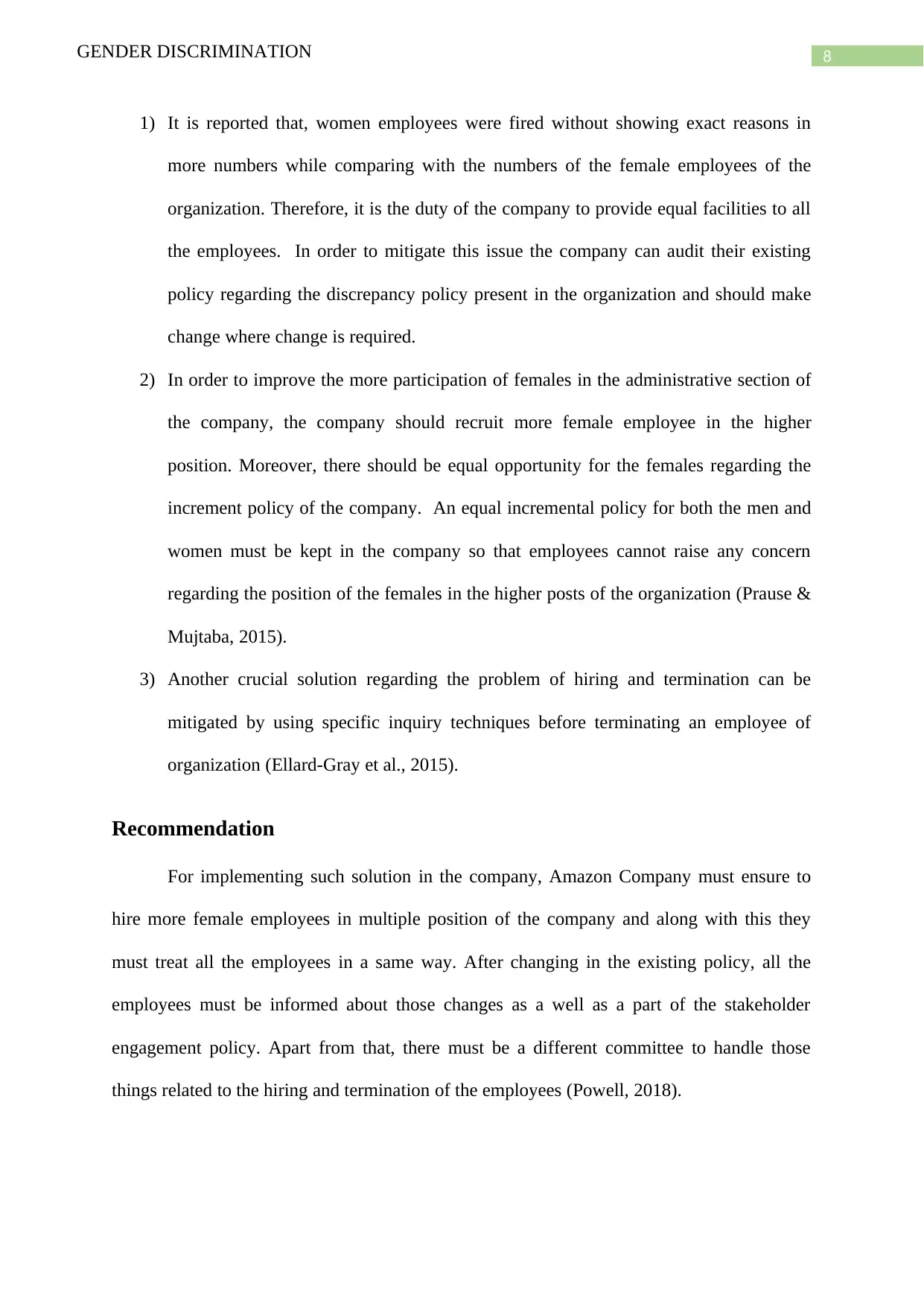
8GENDER DISCRIMINATION
1) It is reported that, women employees were fired without showing exact reasons in
more numbers while comparing with the numbers of the female employees of the
organization. Therefore, it is the duty of the company to provide equal facilities to all
the employees. In order to mitigate this issue the company can audit their existing
policy regarding the discrepancy policy present in the organization and should make
change where change is required.
2) In order to improve the more participation of females in the administrative section of
the company, the company should recruit more female employee in the higher
position. Moreover, there should be equal opportunity for the females regarding the
increment policy of the company. An equal incremental policy for both the men and
women must be kept in the company so that employees cannot raise any concern
regarding the position of the females in the higher posts of the organization (Prause &
Mujtaba, 2015).
3) Another crucial solution regarding the problem of hiring and termination can be
mitigated by using specific inquiry techniques before terminating an employee of
organization (Ellard-Gray et al., 2015).
Recommendation
For implementing such solution in the company, Amazon Company must ensure to
hire more female employees in multiple position of the company and along with this they
must treat all the employees in a same way. After changing in the existing policy, all the
employees must be informed about those changes as a well as a part of the stakeholder
engagement policy. Apart from that, there must be a different committee to handle those
things related to the hiring and termination of the employees (Powell, 2018).
1) It is reported that, women employees were fired without showing exact reasons in
more numbers while comparing with the numbers of the female employees of the
organization. Therefore, it is the duty of the company to provide equal facilities to all
the employees. In order to mitigate this issue the company can audit their existing
policy regarding the discrepancy policy present in the organization and should make
change where change is required.
2) In order to improve the more participation of females in the administrative section of
the company, the company should recruit more female employee in the higher
position. Moreover, there should be equal opportunity for the females regarding the
increment policy of the company. An equal incremental policy for both the men and
women must be kept in the company so that employees cannot raise any concern
regarding the position of the females in the higher posts of the organization (Prause &
Mujtaba, 2015).
3) Another crucial solution regarding the problem of hiring and termination can be
mitigated by using specific inquiry techniques before terminating an employee of
organization (Ellard-Gray et al., 2015).
Recommendation
For implementing such solution in the company, Amazon Company must ensure to
hire more female employees in multiple position of the company and along with this they
must treat all the employees in a same way. After changing in the existing policy, all the
employees must be informed about those changes as a well as a part of the stakeholder
engagement policy. Apart from that, there must be a different committee to handle those
things related to the hiring and termination of the employees (Powell, 2018).
⊘ This is a preview!⊘
Do you want full access?
Subscribe today to unlock all pages.

Trusted by 1+ million students worldwide
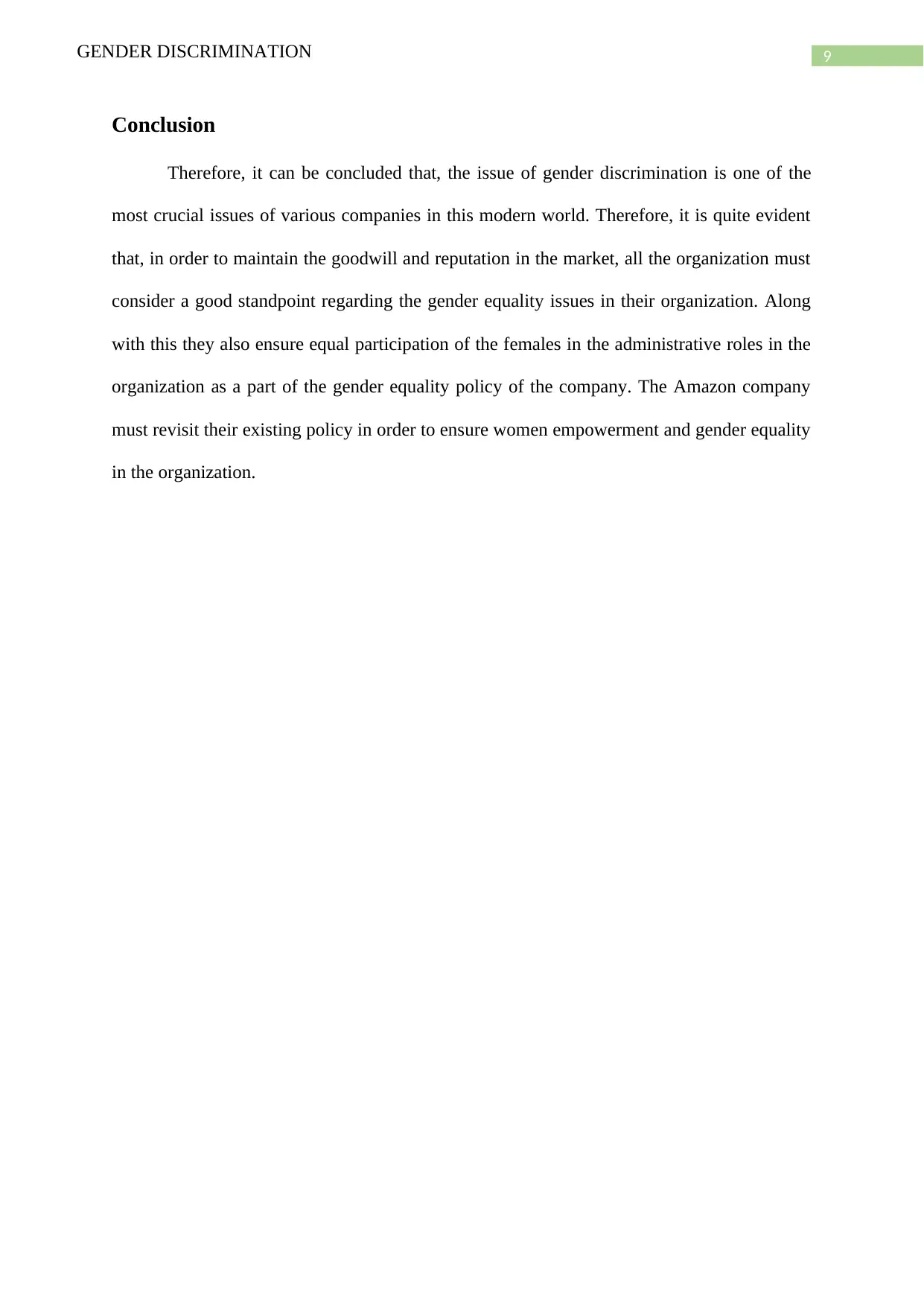
9GENDER DISCRIMINATION
Conclusion
Therefore, it can be concluded that, the issue of gender discrimination is one of the
most crucial issues of various companies in this modern world. Therefore, it is quite evident
that, in order to maintain the goodwill and reputation in the market, all the organization must
consider a good standpoint regarding the gender equality issues in their organization. Along
with this they also ensure equal participation of the females in the administrative roles in the
organization as a part of the gender equality policy of the company. The Amazon company
must revisit their existing policy in order to ensure women empowerment and gender equality
in the organization.
Conclusion
Therefore, it can be concluded that, the issue of gender discrimination is one of the
most crucial issues of various companies in this modern world. Therefore, it is quite evident
that, in order to maintain the goodwill and reputation in the market, all the organization must
consider a good standpoint regarding the gender equality issues in their organization. Along
with this they also ensure equal participation of the females in the administrative roles in the
organization as a part of the gender equality policy of the company. The Amazon company
must revisit their existing policy in order to ensure women empowerment and gender equality
in the organization.
Paraphrase This Document
Need a fresh take? Get an instant paraphrase of this document with our AI Paraphraser
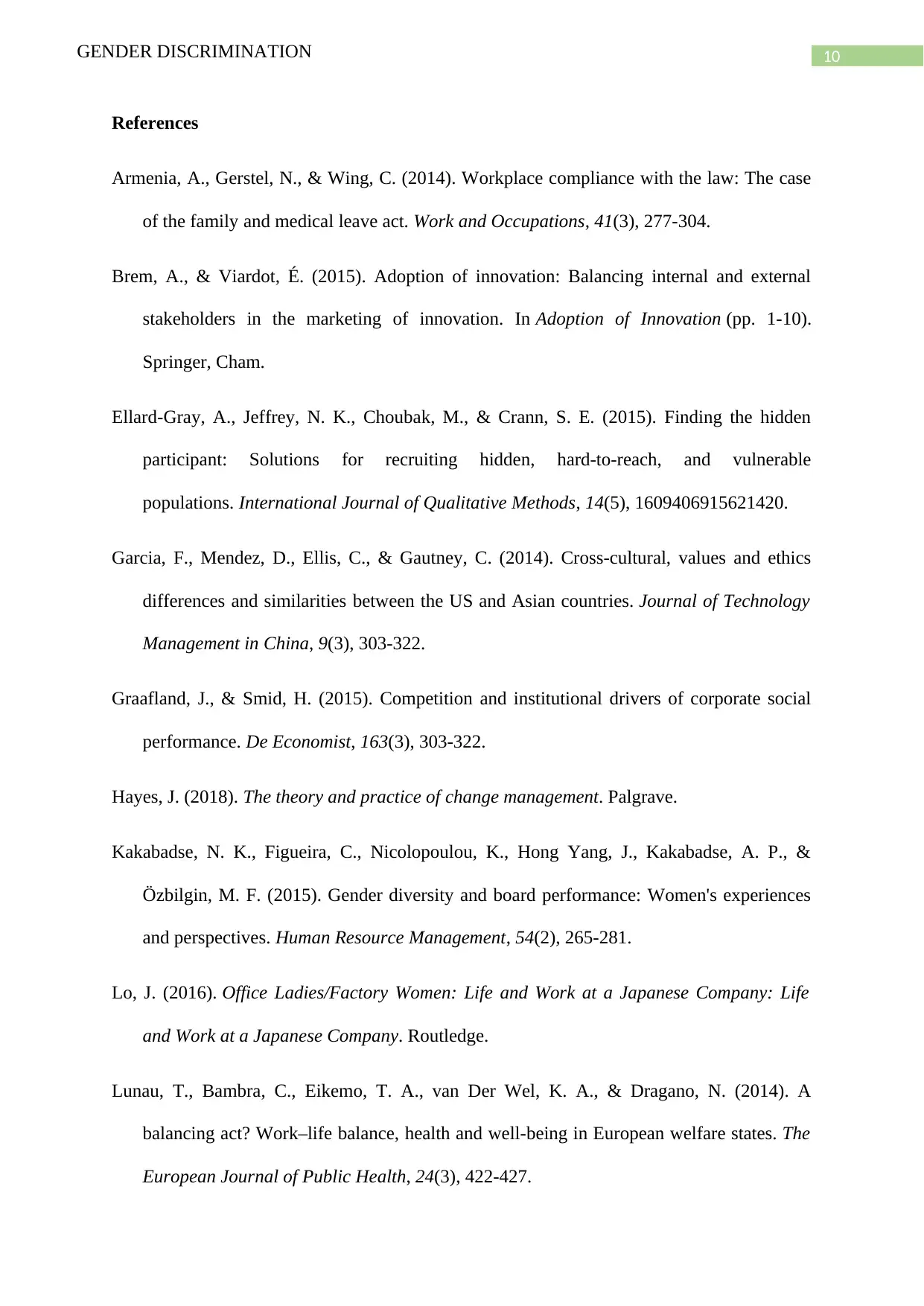
10GENDER DISCRIMINATION
References
Armenia, A., Gerstel, N., & Wing, C. (2014). Workplace compliance with the law: The case
of the family and medical leave act. Work and Occupations, 41(3), 277-304.
Brem, A., & Viardot, É. (2015). Adoption of innovation: Balancing internal and external
stakeholders in the marketing of innovation. In Adoption of Innovation (pp. 1-10).
Springer, Cham.
Ellard-Gray, A., Jeffrey, N. K., Choubak, M., & Crann, S. E. (2015). Finding the hidden
participant: Solutions for recruiting hidden, hard-to-reach, and vulnerable
populations. International Journal of Qualitative Methods, 14(5), 1609406915621420.
Garcia, F., Mendez, D., Ellis, C., & Gautney, C. (2014). Cross-cultural, values and ethics
differences and similarities between the US and Asian countries. Journal of Technology
Management in China, 9(3), 303-322.
Graafland, J., & Smid, H. (2015). Competition and institutional drivers of corporate social
performance. De Economist, 163(3), 303-322.
Hayes, J. (2018). The theory and practice of change management. Palgrave.
Kakabadse, N. K., Figueira, C., Nicolopoulou, K., Hong Yang, J., Kakabadse, A. P., &
Özbilgin, M. F. (2015). Gender diversity and board performance: Women's experiences
and perspectives. Human Resource Management, 54(2), 265-281.
Lo, J. (2016). Office Ladies/Factory Women: Life and Work at a Japanese Company: Life
and Work at a Japanese Company. Routledge.
Lunau, T., Bambra, C., Eikemo, T. A., van Der Wel, K. A., & Dragano, N. (2014). A
balancing act? Work–life balance, health and well-being in European welfare states. The
European Journal of Public Health, 24(3), 422-427.
References
Armenia, A., Gerstel, N., & Wing, C. (2014). Workplace compliance with the law: The case
of the family and medical leave act. Work and Occupations, 41(3), 277-304.
Brem, A., & Viardot, É. (2015). Adoption of innovation: Balancing internal and external
stakeholders in the marketing of innovation. In Adoption of Innovation (pp. 1-10).
Springer, Cham.
Ellard-Gray, A., Jeffrey, N. K., Choubak, M., & Crann, S. E. (2015). Finding the hidden
participant: Solutions for recruiting hidden, hard-to-reach, and vulnerable
populations. International Journal of Qualitative Methods, 14(5), 1609406915621420.
Garcia, F., Mendez, D., Ellis, C., & Gautney, C. (2014). Cross-cultural, values and ethics
differences and similarities between the US and Asian countries. Journal of Technology
Management in China, 9(3), 303-322.
Graafland, J., & Smid, H. (2015). Competition and institutional drivers of corporate social
performance. De Economist, 163(3), 303-322.
Hayes, J. (2018). The theory and practice of change management. Palgrave.
Kakabadse, N. K., Figueira, C., Nicolopoulou, K., Hong Yang, J., Kakabadse, A. P., &
Özbilgin, M. F. (2015). Gender diversity and board performance: Women's experiences
and perspectives. Human Resource Management, 54(2), 265-281.
Lo, J. (2016). Office Ladies/Factory Women: Life and Work at a Japanese Company: Life
and Work at a Japanese Company. Routledge.
Lunau, T., Bambra, C., Eikemo, T. A., van Der Wel, K. A., & Dragano, N. (2014). A
balancing act? Work–life balance, health and well-being in European welfare states. The
European Journal of Public Health, 24(3), 422-427.

11GENDER DISCRIMINATION
Mihăilă, R. (2016). Female labor force participation and gender wage discrimination. Journal
of Research in Gender Studies, 6(1), 262-268.
Okechukwu, C. A., Souza, K., Davis, K. D., & de Castro, A. B. (2014). Discrimination,
harassment, abuse, and bullying in the workplace: contribution of workplace injustice to
occupational health disparities. American journal of industrial medicine, 57(5), 573-586.
Patch, J. (2018). Report: Amazon Falls Short on Gender Equity. realclearpolicy.com.
[Online] Retrieved from-
https://www.realclearpolicy.com/articles/2018/10/09/report_amazon_falls_short_on_gen
der_equity_110846.html [Accessed on- 22nd August 2019].
Powell, G. N. (2018). Women and men in management. Sage Publications.
Prause, D., & Mujtaba, B. G. (2015). Conflict management practices for diverse
workplaces. Journal of Business Studies Quarterly, 6(3), 13.
Terjesen, S., & Sealy, R. (2016). Board gender quotas: Exploring ethical tensions from a
multi-theoretical perspective. Business Ethics Quarterly, 26(1), 23-65.
Mihăilă, R. (2016). Female labor force participation and gender wage discrimination. Journal
of Research in Gender Studies, 6(1), 262-268.
Okechukwu, C. A., Souza, K., Davis, K. D., & de Castro, A. B. (2014). Discrimination,
harassment, abuse, and bullying in the workplace: contribution of workplace injustice to
occupational health disparities. American journal of industrial medicine, 57(5), 573-586.
Patch, J. (2018). Report: Amazon Falls Short on Gender Equity. realclearpolicy.com.
[Online] Retrieved from-
https://www.realclearpolicy.com/articles/2018/10/09/report_amazon_falls_short_on_gen
der_equity_110846.html [Accessed on- 22nd August 2019].
Powell, G. N. (2018). Women and men in management. Sage Publications.
Prause, D., & Mujtaba, B. G. (2015). Conflict management practices for diverse
workplaces. Journal of Business Studies Quarterly, 6(3), 13.
Terjesen, S., & Sealy, R. (2016). Board gender quotas: Exploring ethical tensions from a
multi-theoretical perspective. Business Ethics Quarterly, 26(1), 23-65.
⊘ This is a preview!⊘
Do you want full access?
Subscribe today to unlock all pages.

Trusted by 1+ million students worldwide
1 out of 12
Related Documents
Your All-in-One AI-Powered Toolkit for Academic Success.
+13062052269
info@desklib.com
Available 24*7 on WhatsApp / Email
![[object Object]](/_next/static/media/star-bottom.7253800d.svg)
Unlock your academic potential
Copyright © 2020–2025 A2Z Services. All Rights Reserved. Developed and managed by ZUCOL.





